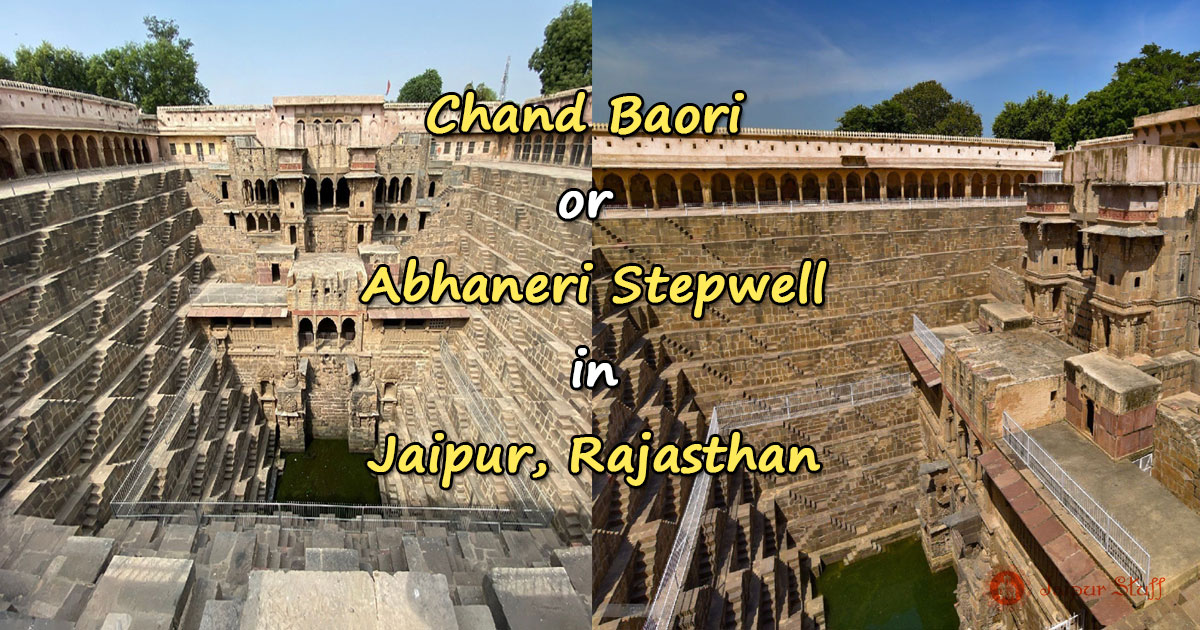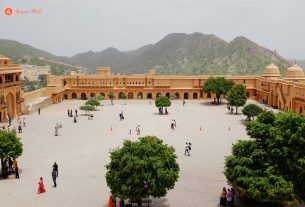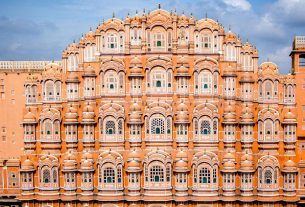Chand Baori in Abhaneri is a must-see place and tourist attraction of Rajasthan. Built in the 8th century, Chand Baori is one of the oldest step wells (baori) of Rajasthan. Rajasthan being a dry desert state, construction of stepwells is common here. This artistically marvel stepwell is still functional and well-preserved. Many tourists come here to see Chand Baori stepwell. In fact, it is one of the few tourist destinations in India that attracts more foreign tourists than domestic tourists. Chand Baori is the most beautiful and illustrative stepwell in India. This is a 13-floor deep stepwell. Inside the stepwell, you will see the symmetrical triangular structure of the steps leading to the water surface.
Table of Contents
Why was Chand Baori built?
Situated in the desert state area, the original purpose of building the Abhaneri Step Well was to store water since the region experiences dry monsoons. Due to this, water scarcity has always been a major issue and to counter this, Raja Chanda built the stepwell.
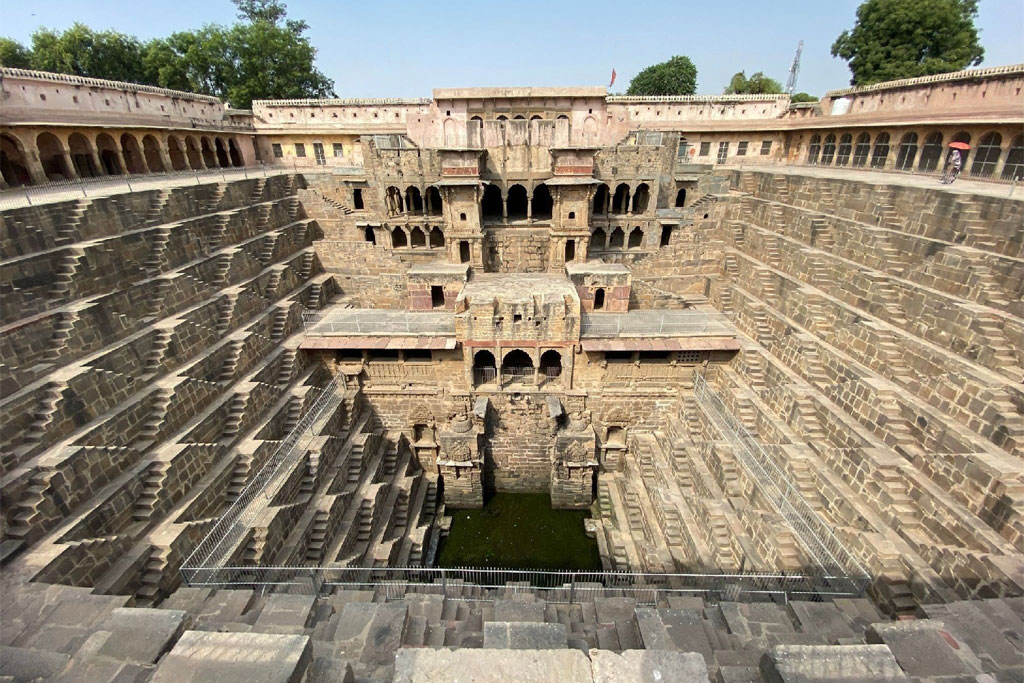
Along with being an excellent water management system, these stepwells also provide coolness in the atmosphere in the summer season. The bottom of the well is five to six degrees lower than the regional temperature. The architecture also boasts of natural light and air that further keeps the temperature lower. For instance, the jharokhas, native to Rajasthani culture, allow sunlight and wind to pass through.
Another reason behind making a water management system so architecturally beautiful is that the stepwell became a venue for entertainment and performing arts and ritual ablutions in the nearby Harshat Mata Temple.
Also, the locals would assemble on the steps for community meetings, performances or social gatherings. This explains the huge performing stage that is also part of this structure. On the floor there are platforms for games resembling chess (shatranj), which indicate that apart from being a place of worship, it was also a place of public meeting.
History of Abhaneri Chand Baori
Chand Baori is the oldest stepwell in Rajasthan and probably the whole of India, which is still alive. This deepest stepwell in India was built in the 8th century by King Chanda of the Nikhumba Dynasty which ruled the region for almost 400 years. Raja Chanda had his faith in Harshat Mata, the goddess of joy and happiness. To please Harshat Mata and help the people in his kingdom, Raja Chanda built this step well. Also, there was a temple attached to the stepwell dedicated to Harshat Mata.
In the 18th century when the Mughals invaded the region, they rebuilt the stepwell and constructed walls and built some galleries around the well. However, as different rulers, including the British, came in over centuries, lack of maintenance and care has resulted in the site failing to establish itself as a mainstream tourist spot. The Archaeological Survey of India (ASI) took over the site in 1955 to look after it and bring back its former glory.
Chand Baori stepwell Architecture
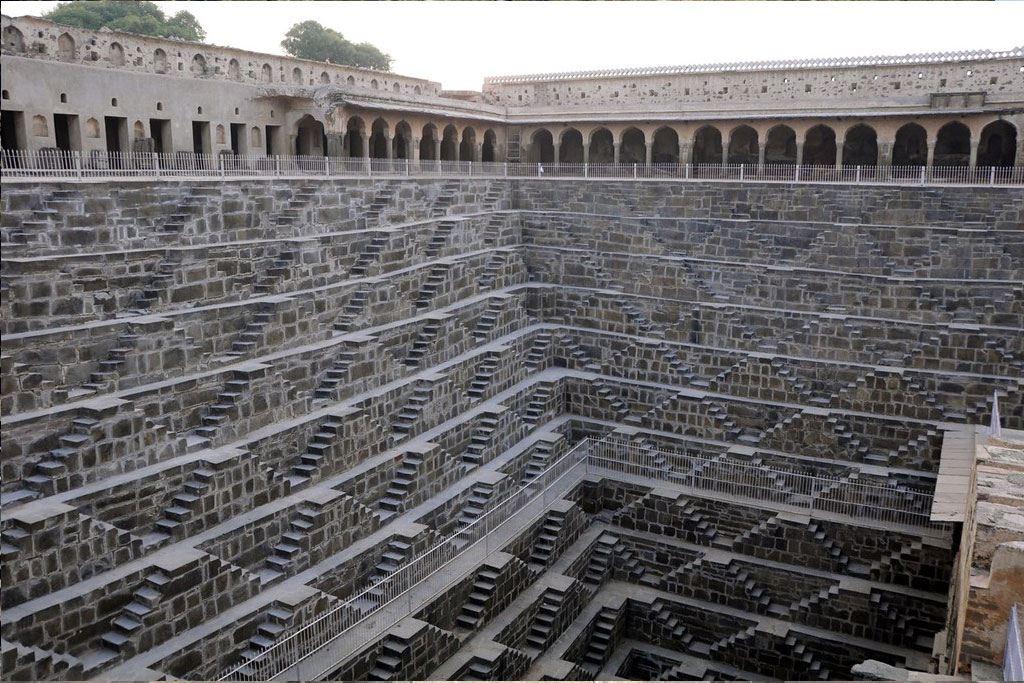
Abhaneri Step Well was a living example of the royal and glorious past. It is regarded amongst the most picturesque step wells in Jaipur, Rajasthan as well as in the world. The unique structural formation of the stepwell with its peculiar design has attracted a lot of attention. It still boasts of the amazing mathematical precision and the ancient Indian sculptural style of the bygone eras. Though this structure is 1200 to 1300 years old, it has remained in remarkable condition. Three sides of the well are covered by the stairs and the fourth side has a pavilion and rooms that once housed royalty.
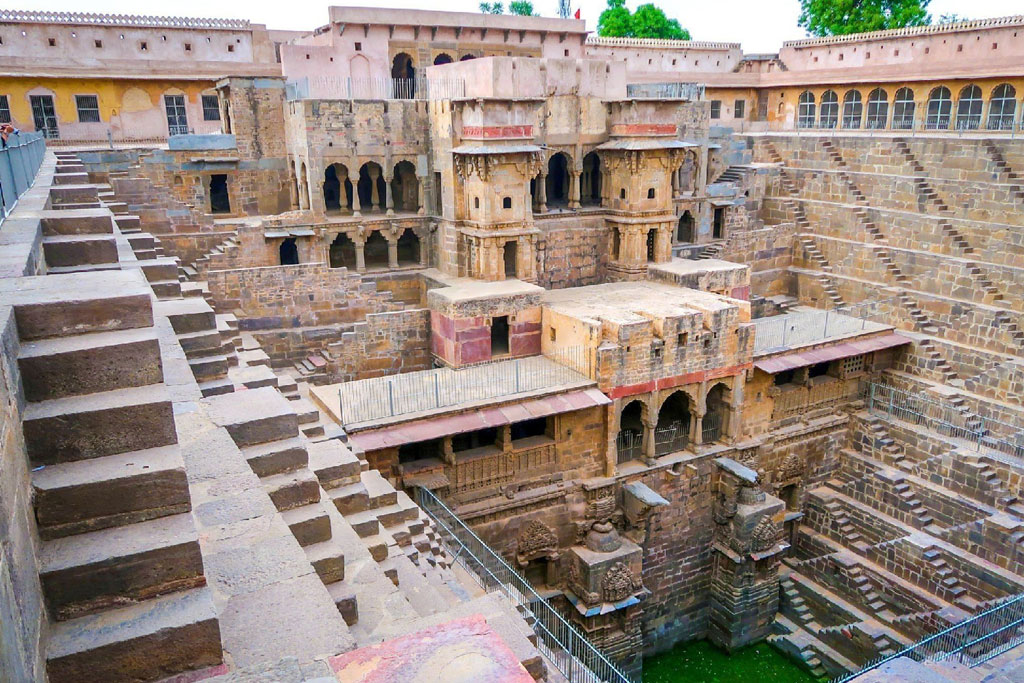
The top of the pavilions has several jharokhas (windows) to get a view of the well from here. The bottom most part of the pavilions has gaps that hold stone sculptures in them along with religious carvings. The pavilion houses a grand room with a separate stage that is believed to have been meant for the royals to enjoy performances by artists of the court. There is also a room that appears to be the royal residence. There are galleries that take visitors towards the balconies projecting out, which are supported by pillars and house beautiful sculptures of Goddess Mahishasurmardini and Lord Ganesha. The structure also has a fascinating room called Andheri Ujala.
The artistic steps of Abhaneri stepwell
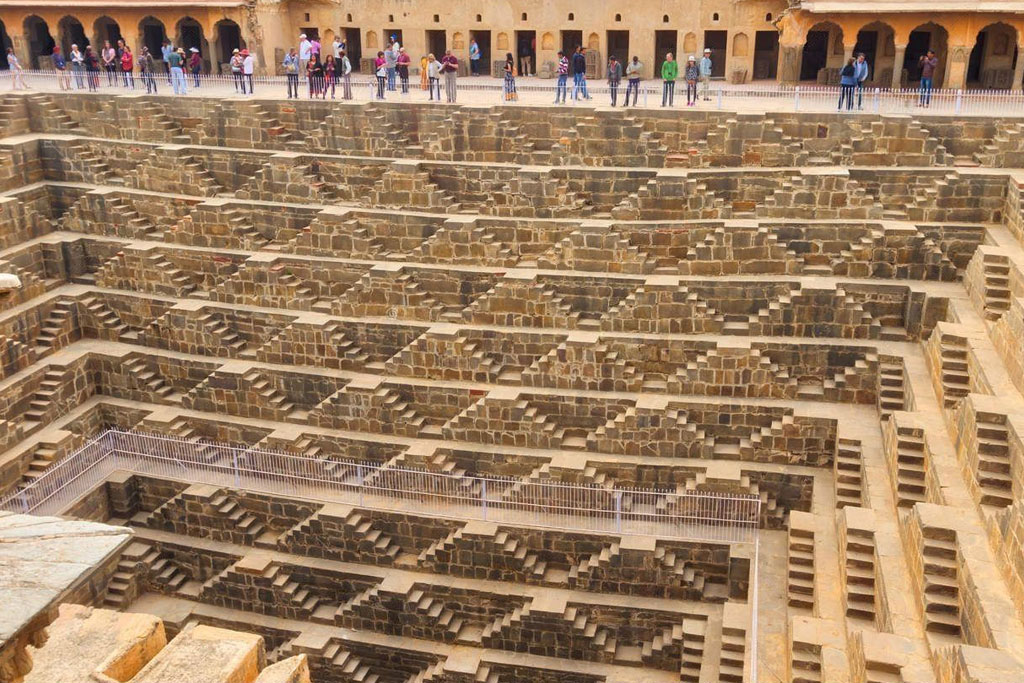
Surrounded by pillared corridors, this stepwell is square from all sides, on the three walls of this stepwell,19.5 meters deep, there are steps giving geometric shapes. 3500 steps have been made in 13 floors till the bottom of the stepwell, which presents an example of amazing art. These steps have been made in an attractive as well as an artistic method. The triangular pattern of the steps makes one climb down sideways and this adds to the aesthetics of the architecture. The other possible reason to build the steps in such a fashion is to allow access to more people at one time. The steps of the stepwell make it look like a magical structure and if viewed from a particular distance, they look like an optical illusion.
A closer look at the bottom of the steps would reveal the presence of pillar-like concealed shafts which were supposedly used to pull water out from the pool. Its construction has been done so carefully that it seems to merge into the structure of the stepwell.
Sitting Corridor at Chand Baori
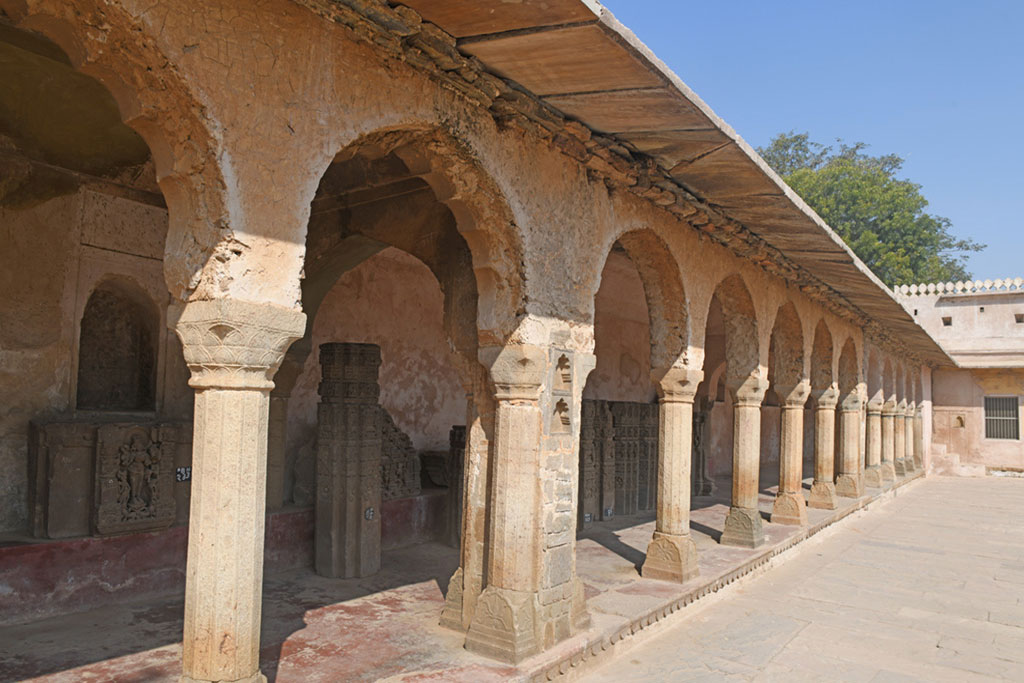
On the fourth wall, there are pillared corridors in several floors. There are two atriums, ie, turret-like structures facing forward, which are facing the stepwell. On the lower floor of the stepwell, the grand statues of Ganesh and Mahishasurmardini were adding to the beauty of the stepwell. There is a replica of Sheshasayee Vishnu inside a lower corridor of Chand Baori. Since tourists are not allowed inside the stepwell, this could not be seen. In fact, the stepwell or any water source is considered to be the form of Kshirsagar, the ocean of milk where Lord Vishnu resides. Many excavated artifacts are kept in this corridor such as:
- Shiva’s head in red stone, meditative Shiva and Shiva-Parvati
- Vishnu and Parashurama in Kalki avatar
- Kartikeya
- Finely carved Mahishasuramardini
- The panels of Brahma, Vishnu and Mahesh
- Harshat or Harsiddhi Mata
- Lakshmi
- Jain idols
- Idols of Yakshas
- Attractive engraved pillars
It should be noted that the entire structure is built out of porous volcanic rocks and stones. This enables the water to seep through the stones and reach to the bottom of the water pool or the well.
Prime attractions
Harshat Mata temple
If you look towards the western side of Chand Baori stepwell, you will see a small temple situated on a high platform at a distance of about 100 meters. This domed temple is Harshat Mata temple whose beautiful ruins are still preserved and highly admired for intricate carvings and engravings. In some inscriptions, Harshat Mata is also called Harsiddhi Mata, the goddess of joy and happiness. Harshat Mata Temple and Chand Baori are contemporary structures. They were built by the same king in the same period. The walls of Harshat Mata Temple speak art with carvings of sunflowers on the stone walls. These flowers were adding to the beauty of the statues built on the walls. Moreover, on the occasion of Navratri, Shakti Puja is performed here.

The original structure of the structure that appears as the central dome is said to have been a shikhara tower, typical of any Hindu temple. The original temple is believed to have been built in the panchayatana style where the central shrine is surrounded by four other shrines. All the shrines are in ruins today with very little of the original structures left.
The temple was ravaged by Muhammad Gazni when he invaded India during the 10th Century and is in ruins till date. The damaged pillars and statues of the temples still lie scattered around the main temple complex and its corridors. The central structure of the temple is a domed structure at present, with stone-sculpted columns and pillars.
Abhaneri festival
The Abhaneri Mahotsav is organized in Abhaneri at the end of the monsoon, every year. The annual two day festival usually comes around Sharad Navratri, 10 days before Dussehra or 30 days before Diwali. This Abhaneri festival attracts domestic and international tourists to the area. The steps are decorated and several art forms such as Kalbeliya and Khayal are performed there.
It is a 3-day grand and majestic festival marked with various cultural performances of music, dances and puppet shows with a fair of local crafts. Along with this, a jumping competition is also organized inside the stepwell. The Abhaneri festival is organized in honour of Harshat Mata, the presiding deity of the village. On the occasion of this festival, the Chand Baori stepwell remains open for 3 days for tourists.
Jaipur chand baori facts
The city, which is called Abhaneri at present, was known as Abha Nagari back then and the step well was named after the King Chand Raja himself.
The name of the village, Abhaneri has its origins from the blessings of Harshat Mata who endowed to spread brightness (abha) in the lives of the people.
The Chand Baori of Abhaneri is so spectacular that it has served as the setting for several films, such as Bhool Bhulaiyaa, Paheli, Best Exotic Hotel Marigold. The Fall and The Dark Knight Rises, where Batman portrays as a prisoner attempting to escape ‘The Pit’.
According to the locals, the Baori was built in one night which is practically impossible. Hence, people believe that this miraculous task was given to a Genie giving it a supernatural twist.
A person can not use the same staircase twice. They have to climb up from the different steps of stairs from which they stepped down. No one has ever been able to step on the same stairs twice even if they tried.
Timings
From 8:00 am to 6:00 pm
Visit Duration
Approx 30 minutes to 1 hour is enough time to visit Abhaneri. Although those who love history and photography can spend more hours to closely inspect each and every artifact.
Best time to visit Chand Baori Abhaneri
The best time to visit Abhaneri Step Well is between October and March. During October or November, one can also experience the 3-day Abhaneri Festival. Apart from this, tourists also recommend visiting the place during monsoon as during this time the stepwell is full with water.
Abhaneri stepwell Entry fees
For Indians: Rs. 30
For foreigners: Rs. 350
Abhaneri Step Well Jaipur contact
076119 76587
Address
Near Harshat Mata Temple, Abhaneri, Dausa, Bandikui, Rajasthan, 303313, India
Location
Abhaneri Step Well is located in the Abhaneri Village in Dausa district of Rajasthan. It is near the Jaipur-Agra highway and chand baori distance is 100kms away from Jaipur. The nearest town near Abhaneri Step Well is Bandikui which is around 8kms away.
How to reach
Chand Baori is accessible only by road. The nearest city to the Abhaneri village is Jaipur. One can take the Jaipur-Agra highway to reach the Abhaneri village. You can rent a cab or take your private vehicle.
The second alternative route is to catch a bus to Gular from Jaipur. From Gular, you can walk for an hour to reach Abhaneri.
The other alternative routes are from the town of Sikandra. A single journey from Jaipur to Sikandra costs Rs.20. From Sikandra, you can hire a jeep to Abhaneri which could cost you around Rs. 250 to Rs. 300.
